RENEGADE GARDENER™
The lone voice of horticultural reason
Carefree Cuts: How to Prune Shrubs
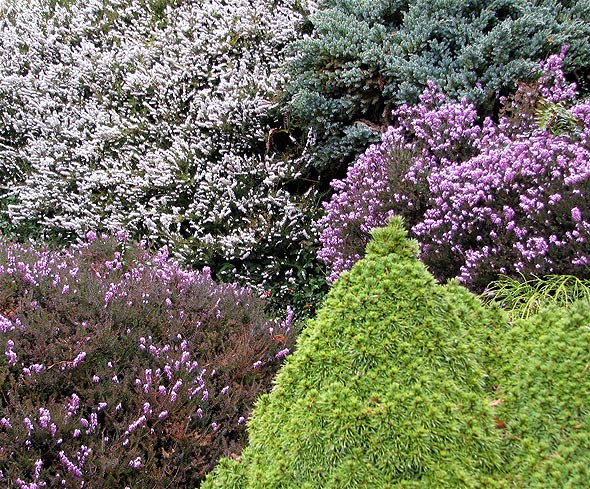
Shrub beauty, health and longevity come from proper pruning.
5-7-12 –People will buy an expensive piece of leather clothing and take it to a specialist across town for cleaning, they’ll pay trained mechanics for simple stuff like oil changes and tire rotations, even call an electrician when a circuit trips, but still stagger out into their yards with grampa’s dull hatchet and flail away at their overgrown shrubs as if they have an advanced degree in botany. Year after year, the shrubs look worse.
I don’t get it. Pruning is not complicated, once you know about a dozen things, a dozen things you are about to learn. Herein I will detail pruning techniques for both deciduous and evergreen shrubs. Put on a pot of coffee and break out the beanbag chairs, this is a long one.
Proper Tools
A hatchet is not one of them. Nor is an axe, a handsaw made for lumber, or knives of any kind. If you own a yard, you own shrubs, and if you own shrubs, you need to own the following tools:

Bypass lopper top, bypass pruner bottom.
Bypass Pruner – This is your number one tool. It is so named because the top, curved cutting blade bypasses the wider, curved bottom portion that secures the branch you are cutting. Buy a good one – at least thirty bucks – with replaceable blades. It should last for decades. Good bypass pruners come right-handed and left-handed. A right-handed model has the blade to the right as you look down on it; reverse for left-handed. This is important, as we shall see.
Bypass pruners are used for small branches, up to around index finger-size, depending on your hand strength, and, I suppose, the size of your index finger. (It’s also what you use for pruning/deadheading most perennials.) They make ratchet hand pruners, where each time you squeeze the handle, it cuts a bit, then ratchets to reload, then you squeeze again, until the blade cuts through the branch. They work well, but again, spend some money. Cheap ratchet pruners break. Ratchet pruners are great for older or petite gardeners who lack hand strength. I don’t own one because I prefer to have my fingers and palm ache for two days after a long stint of pruning, particularly when I choose to prune branches the size of a hot dog with my bypass pruner, because I forgot my lopper at a shrub ten feet away.

The cutting blade of a bypass pruner slides by (bypasses) the curved lower portion.
Do NOT purchase or own an anvil pruner. An anvil pruner looks much like a bypass pruner, except the blade edge is FLAT, and when closed, rests directly in the center of the wide, flat bottom portion. So named I think because it summons the thought of a hand sledge striking an anvil. Anvil pruners squish and damage branches as they close and cut, often with subtle tearing of tender bark. The only reason you see them for sale is they came first. Later, tool designers figured out that pruning tools with a bypassing blade (similar to scissors) make a more precise, sharper and cleaner cut. Why anvil pruners are still sold is a mystery. If you own one, toss it.
Bypass Lopper – A larger version of bypass pruner, with two long handles requiring use of both hands. Use these for larger branches, hotdog size and up. Yes, you can still find anvil-style bypass pruners, and with those you will really have to work hard while making a mess of things. No reason for their existence. Loppers come with the ratchet feature also, and are a very good investment, unless you go cheap.
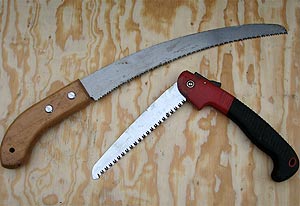
Pruning saws
Pruning Saw – Wise to own two, a large one with at least a twelve-inch-long blade, and a smaller version. The smaller saw may have a blade that folds into the handle, similar to a pocketknife. Pruning saws are used primarily for thinning deciduous shrubs at the base, or as close to the ground as you can get.
Either way, the blade is narrow and the entire tool curved from handle to blade, so you can cut in a crowded clump of base stems without the top edge of the blade tearing bark on the nearby trunks or stems you do not wish to remove.
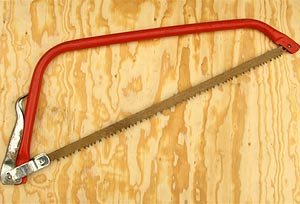
Band saw.
Band Saw – Used most often for cutting branches from trees, and not at all useful in tight spots, but it has much larger teeth and cuts quicker than a pruning saw in those situations where you want to cut a thick trunk of a large shrub, and have the room to get at it with a band saw. These things are very sharp, and will cut even a six-inch-diameter trunk quicker than getting out the chainsaw, checking the gas level, and firing it up.
Hedge Shears – Used for shearing evergreen shrubs such as yew, arborvitae, juniper, chamaecyparis, etc., in addition to the leaves and very slender tip branches securing the leaves of deciduous plants such as boxwood, barberry, Japanese euonymus, holly, spirea and oleander. But the key is, a hedge shears is used on these shrubs only if they are being maintained as a sheared plant or hedge. They are for giving shrubs very slight haircuts, and are worthless if your intent is to alter the size or shape of a shrub to any great degree. That is the job of pruners and saws. You never reduce the height, to any great degree, of a dogwood, ninebark, viburnum, lilac or any other shrub, with a hedge shears.
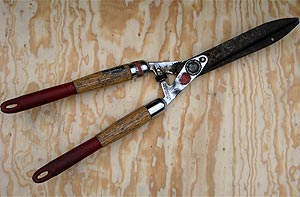
Hedge shears.
Electric hedge shears work great for shearing, and are worth the investment after you acquire more than three or four shrubs that you choose to keep sheared. It makes the job so quick. Be careful with these things – they make shearing so effortless that you forget the blades are moving, and they will easily take off a finger. Keep track of the cord also. If I had a dollar for every time I’ve lowered the tool to my side while stepping back to eyeball my progress on a hedge and inadvertently cut the extension cord with the blade, I’d have enough for a venti mocha at Starbuck’s.
Always wear good quality, tight fitting gloves when using any of the above tools. Eye protection bears note – I am one person you know who knows exactly what it feels like to get a sharp stick in the eye. Anything beats it. At the least, wearing safety glasses when using an electric hedge shears is not a bad idea.
When to Prune
This is probably one of the top 10 questions I receive from readers: When do I prune my (fill in the shrub)? Here are the basic rules of thumb:
Prune deciduous shrubs, with the exception of early spring blooming shrubs, when dormant. Anytime in winter is always safe. End of winter/early spring is fine. Pruning shrubs in spring after they have broken dormancy (you see swelling and a bit of pink or red along branches, or even the emergence of leaves) is acceptable, though some articles and guides written by authors who haven’t broken a rule in their lives (or pruned a shrub in thirty years) will stick with “winter only.” Nonsense. If the shrub is starting to show new growth, it has just broken dormancy, but pruning it before it gets much farther along will not result in any great difference in appearance or health from pruning it a month or two earlier.
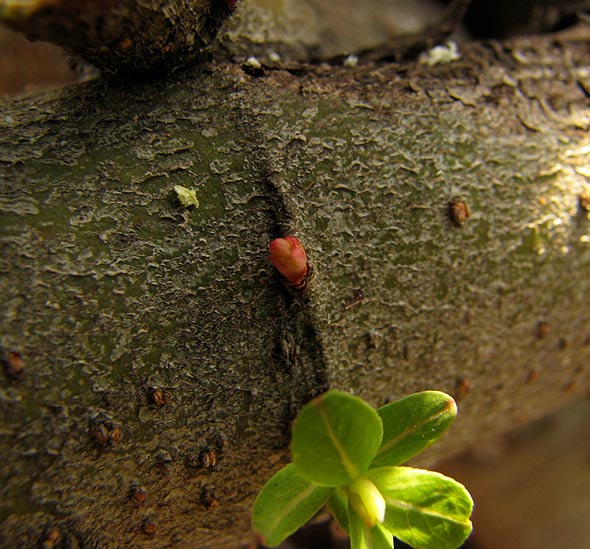
Early node swelling and leaf break, Hakuro Nishiki willow.
In fact, I sometimes prefer pruning deciduous shrubs just as they break dormancy, because you can see which nodes along the trunks and branches are active, helping you decide where to make your cut. A good example is pruning a shrub rose in zones 3-5. It’s not until it breaks dormancy and starts showing reddish nodes that you can tell exactly what portion of the plant is alive and what portion is dead.
Prune early spring blooming shrubs in late spring/early summer, after they have finished blooming. What do early bloomers such as rhododendron, azalea, lilac, forsythia, and shrub-form magnolia have in common? They bloom early because they set their buds the previous summer, and then carried them through winter. Think about it. How could a shrub bloom in April, or mid-May (or sometime in March, in the warmer regions) when it was dormant just a few weeks or a month prior? The plant couldn’t break dormancy in spring, then create a flower bud and pop it open in such a short amount of time.

Rhododendrons (here, ‘Helsinki University’) bloom on old wood.
So we know it is blooming on “old wood,” meaning, last year’s growth. The flower buds were set the year before. If you prune a shrub in winter or early, early spring that blooms on old wood, you will be pruning off branches holding the dormant flower buds. So little or no bloom that spring. You can certainly prune these bloomers in dormancy/winter if that’s the only time you can get around to it. Just be aware that the next spring, you won’t see much bloom. It won’t harm the shrub.
Prune evergreen shrubs in winter, while dormant, with the same caveat as deciduous shrubs. If it’s getting later into spring and the yew or juniper is greening up (or golding up) and showing mild signs of new growth, and you didn’t get to it yet, prune away. You frankly couldn’t do any harm to a giant, spreading juniper if you pruned the branches back in June, and I’ve never met a yew that cares what time of year you prune it, except late summer in zones where it freezes in winter (pruning late summer will cause new, late-season growth that won’t grow tough enough to last through winter).
The reason pruning most deciduous and evergreen shrubs in winter is best, is that the shrub wakes up and doesn’t know it was pruned. It devotes virtually no energy to the fact that part of it was cut off. But the amount of energy devoted to a fresh prune in the early stages of spring growth is negligible. The new season’s growth will, however, be a bit more than if you prune in winter, when plants are completely dormant.
Fresh cuts are wounds to a plant and they do cause minor sap flow around the cut if the plant has broken dormancy, and this activity can be a type of alarm to marauding insects. But this is more of a concern with trees, such as oak, where pruning during the growing season can attract the oak bark beetle that carries the oak wilt fungus. In zones 3-6, there aren’t any insects around in spring that are going to focus in on a freshly pruned shrub. In zones 7-9, I suppose it is wiser to stick with pruning only in winter, if you can call it that.
The reason you do not prune in summer is that the shrub is vitally alive and in growth mode. When you prune a shrub that is actively growing, it will immediately fire out new growth to replace what it has lost, and this new growth, by the end of the season, will often exceed what you pruned away.
When to Prune, Part II
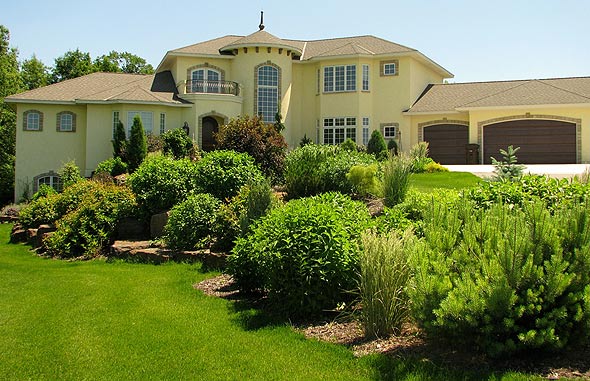
Planted six years ago, this homeowner felt that some of the shrubs in her landscape had grown too large, and I agree.
So now from an aesthetic standpoint, what makes you decide that a shrub needs pruning? Entirely up to you, of course. Some people will look at the shrubs in their yard and think they look just fine, no matter what course the shrubs have taken during their twenty- or forty-year lifespan. I may not want to inspect their toilet or bathtub, but hey, who is anyone to say your shrubs need pruning? If they look fine to you, so be it.
Most of us, however, discover that in as little as five years, shrubs, deciduous in particular, lose their charm. Funny thing about deciduous shrubs, they tend to grow larger than the books tell you. Many will sucker slowly, essentially growing new shrubs at their side, even though the trait isn’t mentioned on the plant tag. Many, many shrubs also will create a new shrub next to it by rooting the tip of a low branch that comes in contact with the ground, even if properly mulched. Dogwoods, ninebarks, barberry, spiraea, forsythia and a hundred more will do this.
Or perhaps you planted evergreen shrubs, and your goal is to keep your yews, pyramidal arborvitaes or upright junipers tight and lush. The time comes, you need to prune your shrubs.
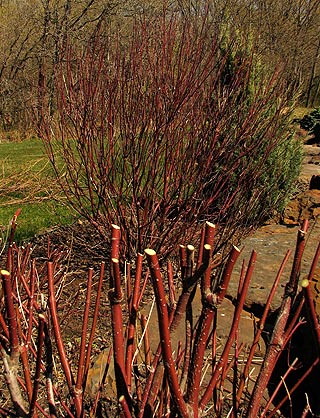
A hard pruning is required to control height. The dogwood in foreground is done, the one in background is next. I am removing two-thirds of the height.
How to Prune
There are numerous pruning techniques to learn, each based on what you are trying to achieve via pruning.
Controlling Height
Here’s the biggest mistake people make pruning deciduous shrubs that are taller than they wish: They hack it down to the height they want right now. Wrong. You are far better off properly pruning the shrub much farther back (sometimes called a hard pruning) so it will be at the size you want in two, three, or even five years.
Pruning six inches or a foot off a deciduous shrub because that’s the height you think is best will result in new growth just below the pruning cuts, that, with many shrubs, will result in new branches twelve inches or more long the first season after pruning. Did you use a hedge shears because it made the job quick? Doomed. Removing only six to twelve inches, you are cutting very young growth, probably last years’, and those branches are the most vitally alive on the entire shrub, with dozens of young, dormant nodes throughout, which will fire off lush new growth when the shrub awakens. One can always tell an improperly pruned shrub when one sees thick, lush growth at the top, and older, sluggish, more naked branches below. These shrubs appear, and indeed are, top heavy.
Nearly every time what the shrub needs is a hard pruning. Depending on size of branch/stem, you use either your bypass pruner or your lopper. You are removing at least one half the height. I typically remove two-thirds. This means you are cutting into old wood, and by old I mean it might be a stem that was present when the shrub was planted. The new growth from these older stems, when the shrub awakens, will not gallop away nearly as quickly, and will not create the top heavy, “witches broom” effect you see from pruning high up on younger wood.
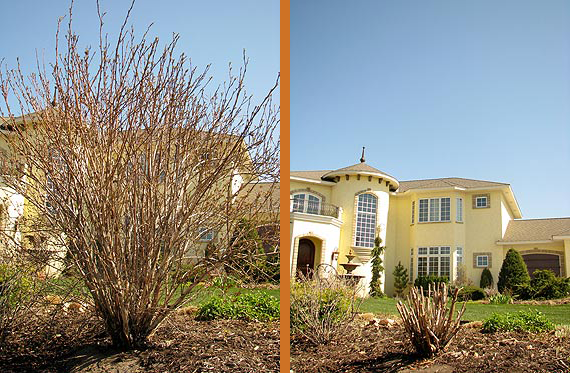
Left, Diabolo ninebark, April, before pruning. Right, same shrub after a hard pruning. Nice day in Minnesota.
Make your first cut in the center of the shrub. Probably using a lopper. This defines your new height. Then you cut the stems around it at the same height. You can proceed this way all the way around the shrub, or, cut the perimeter stems shorter to create a more rounded shape to the shrub. Try to cut below forks, that is, finish with as many single stems as possible. Some stems inevitably will fork below where you make your cut. So be it. But if most of the cuts are just an inch or two above a fork in the remaining base stem, well, you’re starting with two branches right next to each other, each of which is going to send up new branches. You’ll have double the branches coming off above the fork, meaning thicker growth here than over there.
Controlling Width
Controlling shrub width is accomplished either by pruning outside stems at the base, or pruning errant branches part way up, or both. If you prune branches part way up on a vertical stem, make your cut one-quarter inch above an inward facing node, not one on the outside. When the node fires off a new branch in spring, the branch will grow up and in. If the node doesn’t fire, but an outside node below it does, go back when you can see new growth and prune it to an active, inward facing node. If new branches are erupting on both sides, inner and outer, prune the outward growing branch tight to the stem.
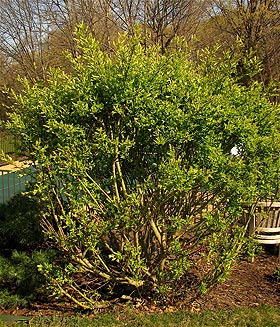
This shrub willow was pruned three years earlier by the homeowner, who didn’t cut down far enough. Note that it’s a bit top-heavy. Yes, it’s a bit late to be pruning.
If the branch or stem is horizontal, as with a great, sprawling Bridal Wreath spiraea, prune to an upward facing node, although in my opinion, the best thing would be to dig up the entire, ancient dog and get rid of it. Plant a different shrub that doesn’t rule your life, while looking like hell for eleven months a year. Sorry. My Twins just lost again.
Something that is rarely mentioned in pruning articles: After pruning in winter/early spring, it’s worth it to go back after the shrub has leafed out to see where the new growth is coming from. You might have pruned an upward-growing stem that now is dead for a length of two to eight inches, the new growth starting down below that.
I will go back in spring (summer is also fine) and prune out those dead stubs. I do this because they are, after all, dead wood in my shrub, because they might be seen later in the season, and most important, because I can’t sleep at night knowing they exist. So go back after the shrub has leafed out and take a close look at what your pruning has caused. Often you’ll want to make a fine-tuning cut here and there, usually to dead stubs and outward-growing branches.
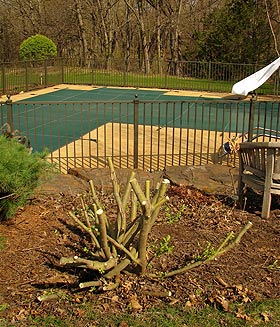
Same shrub after a very hard pruning. It will now grow with even foliage top to bottom. It can be hard pruned again, perhaps in five years, when it gets too large.
Deciduous shrubs that have grown far too large are often candidates for coppicing. Coppicing is the term for cutting a shrub (or certain trees) right down to the ground – only an inch or so of trunk(s) remaining. Some of you may be aghast at how far down I have pruned the shrubs in the pictures. Well, not only do most homeowners not prune hard enough, there’s not a single shrub pictured that would have died had I gone all the way, and coppiced them instead. What you get is virtually a brand-new shrub. Keep coppicing in mind, as you may come upon a situation where it is merited. (Note: deciduous shrubs only. Also, not every single shrub takes well to coppicing, though most do. Probably wise to contact a nursery or your county extension office to make sure the shrub in question will handle it.)
If the shrub has been whistling and trying to look nonchalant for the past several years while secretly expanding its width by growing a new shrub from low-growing branch tips in contact with the ground, you need to recognize them. Usually you can rip these smaller shrubs out of the ground in spring after they show leaves, and cut off the offending branch from the mother shrub at its base. And hey, that little shrub in your hand can be transplanted elsewhere. The shrub just performed a propagation technique called tip rooting.
New growth from underground stolons that are popping up small new shrubs around the base of the original plant are handled the same way. Sometimes you need to dig up these little jailbird shrubs with a spading fork, if you failed to note them for a few years. Dig them up, then find the stolon (for all intents and purposes, the root) that trails back to the mother ship, and cut it short. Once again, you can replant the new little shrub, or give it away.
Renewal Pruning
Sometimes a shrub’s size is not the problem – perhaps you are looking forward to it growing even larger – but after ten years, it looks partially dead. Well, it is. Many of the old, original stems are either dead or don’t produce much new growth. The classic shrub in this case is the lilac. For those readers in zones 7-9, flowering quince, viburnum, or any shrub you grow that gets big and develops old, gray, dead central stems would be the same thing.
These shrubs lose vitality over the years and start looking bad because the old growth is in the way. A renewal pruning involves taking a pruning saw and removing one-third of the oldest, thickest trunks as close to the ground as possible. Remove only the oldest one-third. The next season you can remove another third. About two seasons is all that is needed. Renewal pruning will increase the amount of new stems, or suckers, that emerge from the ground outside the original base. These are fresh new trunks that will grow branches and bloom like mad in a few years. You may get so many that you need to thin some out.
Note that you will also encounter young, vibrant shoots growing straight up from an old, gray trunk that is perhaps dead at the end. Prune off the old portion a half-inch past the young shoot.
I should note that in some parts of the country, “renewal pruning” means cutting the entire shrub to the ground, i.e., coppicing. In those areas, what I am referring to as renewal pruning is called “rejuvenating.” Just so you know.
Some Things to Think About
Early on I mentioned right- and left-handed pruners and loppers. Here’s yet another tip that few other garden writers are anal enough to tell you: You want the blade side of the pruner to be on the side of the wood that will remain. If you are using a bypass pruner or lopper to simply shorten a vertical trunk/stem, this doesn’t apply. The blade side can be on top, or bottom as you cut. It’s when you are pruning one of the branches in a fork, or pruning the portion that extends after a branch that you want to keep, that you pay attention to this.
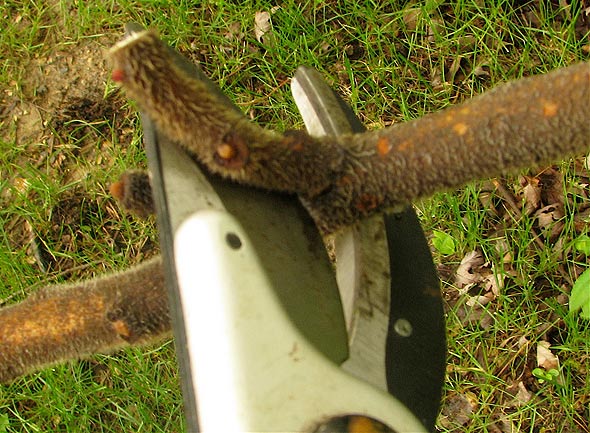
Pruning a semi-horizontal branch on a sumac, that includes a short branch (already pruned) that I want to keep. Note the orientation of the upper cutting blade. It is snug to the wood that will remain after pruning. The portion to the left will drop off.
If you approach the branch so that the portion you are pruning off, either at a fork or at a branch you want to keep, extends out to your left, a right-handed pruner is set to go. A left-handed pruner, you would want to turn it upside down in your hand, or approach the branch from the other side. What I’m saying is, you want to handle the pruner so you can nestle the top cutting blade right into the crotch formed by the two branches. I don’t want to circle a shrub sixteen times as I prune, so I will often flip the pruner upside down in my hand, if that allows me to get the blade exactly where I want to make the cut.
Look at the picture, but e-mail me if I just lost you.
Shearing
Last but not least, a few words on a subtle form of pruning called shearing, performed on both deciduous and evergreen shrubs.
As we have already discussed, anytime you prune a plant while it is growing, it spurs growth. The plant can’t help it. It’s a bad trait for a plant to have if you are pruning a too-large viburnum and you goof up and go at in July. But it’s a good trait if what you want is a lush evergreen or deciduous hedge.
Some shrubs certainly can be sheared while dormant, in winter. These include many varieties of spiraea, andromeda, or any shrub with very fine branches that you want to keep lush with foliage all around. A hedge shears or electric hedge shears does the trick.
But the one scenario in which it pays to prune when the shrub is growing is when you desire a thick, lush look to evergreen shrubs. I wouldn’t waste my time shearing these in winter. Wait until late spring. Let the arborvitae, upright juniper, or Japanese yew show you plenty of new growth, then shear this near growth back by half to two-thirds.

I have just finished shearing these ‘DeGroot’s Spire’ arborvitae, in spring, after their first flush of new growth. They are six years old and get sheared twice a season.
Great time to fertilize the shrub, by the way. In about six weeks, shear it again, not taking off quite as much. Some will do a third shearing in early August. This will keep evergreen shrubs, particularly those used to create a hedge, extremely full and lush, assuming they are receiving adequate sunlight for the variety of evergreen.
This timeframe would apply to boxwoods, also. Other deciduous shrubs that you use for a hedge – and really, if you get into shearing, you can use virtually any leafing shrub as a formal hedge plant – probably need only two shearings per growing season. I’ve seen hedges made using ‘Ivory Halo’ dogwoods in Minnesota that look as if you could bounce a tennis ball off them. But they are sheared two to three times through late spring and summer.
At Last: Conclusion
Remember, you don’t have to wait until a shrub is getting out of hand to start pruning. The first season after planting, I will examine shrubs and sometimes snip a little here and there, mainly small, dead branches. Evergreen shrubs (and dwarf evergreen trees), I’ll take some time in summer to prune off anything that’s dead. And always clear out leaves and debris from the bases of shrubs each spring, it lets the base breath, and dry out after rainfalls. You also want to get in there with your hands and clean out old, dead needles that have dropped and are filling the base of evergreen shrubs. Do this every spring, starting the first year, and it’s never much of a chore.
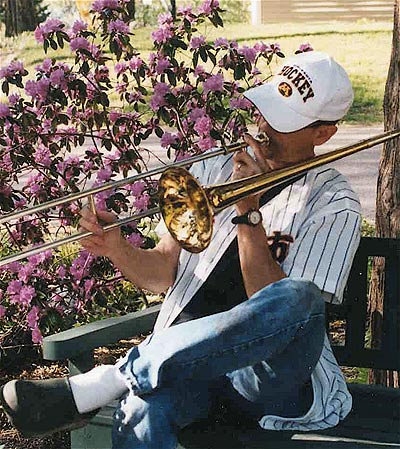 I’m searching my mind trying to think of anything else that helps, and I think we’re about done. It’s May, by the way, meaning this is the last update where I sit and write a new column, until November 1st. My landscaping season is already well underway, and I need to get back to twelve-hour workdays. So June through September, there will be a monthly update, but they are just quickie notes to say hello, often a photo of some job we’re on, and a few clicks to suggested articles from the archives.
I’m searching my mind trying to think of anything else that helps, and I think we’re about done. It’s May, by the way, meaning this is the last update where I sit and write a new column, until November 1st. My landscaping season is already well underway, and I need to get back to twelve-hour workdays. So June through September, there will be a monthly update, but they are just quickie notes to say hello, often a photo of some job we’re on, and a few clicks to suggested articles from the archives.
The other regularly updated feature buttons – Top Pick, Don’t DO That, Myth of the Week and Plant Spotlight – have just gone to Archive Mode until November 1st. Stay healthy, have fun, and have a great summer of gardening. See you, briefly, next month.
Don Engebretson
The Renegade Gardener